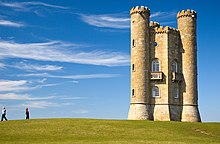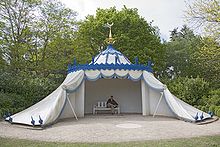
Back جنونية Arabic Капрыз (архітэктура) Byelorussian Capritx (arquitectura) Catalan Folly Czech Ffoledd Welsh Folly (havekunst) Danish Folly (Gartenkunst) German Capricho (arquitectura) Spanish سازه تزئینی Persian Fabrique de jardin French




In architecture, a folly is a building constructed primarily for decoration, but suggesting through its appearance some other purpose, or of such extravagant appearance that it transcends the range of usual garden buildings.
Eighteenth-century English landscape gardening and French landscape gardening often featured mock Roman temples, symbolising classical virtues. Other 18th-century garden follies imitated Chinese temples, Egyptian pyramids, ruined medieval castles or abbeys, or Tatar tents, to represent different continents or historical eras. Sometimes they represented rustic villages, mills and cottages, to symbolise rural virtues.[1] Many follies, particularly during times of famine, such as the Great Famine in Ireland, were built as a form of poor relief, to provide employment for peasants and unemployed artisans.
In English, the term began as "a popular name for any costly structure considered to have shown folly in the builder", the Oxford English Dictionary's definition.[2] Follies are often named after the individual who commissioned or designed the project. The connotations of silliness or madness in this definition is in accord with the general meaning of the French word folie; however, another older meaning of this word is "delight" or "favourite abode".[3] This sense included conventional, practical buildings that were thought unduly large or expensive, such as Beckford's Folly, an extremely expensive early Gothic Revival country house that collapsed under the weight of its tower in 1825, 12 years after completion.
As a general term, "folly" is usually applied to a small building that appears to have no practical purpose or the purpose of which appears less important than its striking and unusual design, but the term is ultimately subjective, so a precise definition is not possible.